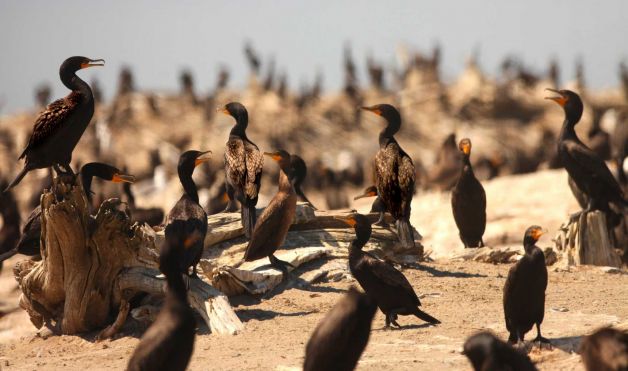forum
library
tutorial
contact

Complexities of Measuring
Effects of Predation on Basin Salmon
by Staff
Columbia Basin Bulletin, October 14, 2016
|
the film forum library tutorial contact |

|
Complexities of Measuring
by Staff
|
Science Advisors Recommend Metrics
 Charged with developing a single metric researchers would use to measure the effects of predator control activities in the Columbia River Basin, an advisory board to the Northwest Power and Conservation Council recommended two approaches, saying that a single metric is not adequate for evaluating all goals.
Charged with developing a single metric researchers would use to measure the effects of predator control activities in the Columbia River Basin, an advisory board to the Northwest Power and Conservation Council recommended two approaches, saying that a single metric is not adequate for evaluating all goals.
The Independent Scientific Advisory Committee recommended to the Council at its meeting in Portland Wednesday the two metrics needed to measure the effects of predation on salmon and steelhead. They are salmon adult equivalents (the impact of a predator control measure on the number of adults returning to the spawning grounds) and changes in the population growth rate.
The Council had asked the ISAB to develop a metric in a letter sent to Dr. Greg Ruggerone March 3, 2016 (nwcouncil.app.box.com/s/59i4ya7chjbsfq78x8n343d52junmb41).
The metric, according to the letter, should measure the effects of predation on salmonids in order to facilitate comparison and evaluation against other factors. The outcome of the work by the ISAB would inform future technical workgroup efforts, allow comparisons of predation across the salmon life cycle, enable evaluation of predation as a factor limiting recovery of species listed under the federal Endangered Species Act and facilitate evaluation of predator control programs.
(Also see CBB, January 15, 2016, Can We Measure Impact Of Predator Management Actions Intended To Protect ESA-Listed Salmon/Steelhead)
Predators have a big impact on salmon survival, Ruggerone told the Council Wednesday as he explained some of the assumptions about predation. "Predation takes a high percentage of the population, yet the population still remains productive. Removal of predators may have unintended consequences."
Predator control efforts in the Basin include California sea lion predation on adult salmon and steelhead, Caspian tern, double-crested cormorant and gull predation on juvenile salmon and steelhead, pikeminnow predation on juveniles, and Northern Pike predation in the upper Columbia River basin, particularly in Lake Roosevelt where the pike exist but do not yet feed on anadromous salmonids.
"At first glance, developing a metric to evaluate the consequences of predation on salmonid populations might seem straightforward," an October 4 Council memorandum says, "Predators take individuals from a population and cause a corresponding decline in salmonid abundance. However, it can be misleading to assume that mortality at each life stage accumulates additively over the salmonid life cycle if other factors compensate for this mortality."
There are three types of predation mortality: additive, compensatory and depensatory.
Additive mortality causes an immediate reduction in total survival across the entire life of a salmon. If density dependence is not present and predation is non-selective, then predation is additive, Dr. Steve Schroder of the ISAB told the Council.
Additive is the most straightforward
"Additive is the most straightforward and has an immediate impact on the population," he said. "If 10 percent of all juveniles are killed by a predator, then that has a 10 percent impact on adults."
Compensatory mortality is more complicated and occurs when predation at one life stage is offset by decreased mortality at the same or subsequent life stages. It is impacted by density dependence, predator selectivity and predators switching to other prey, Schroder said.
Most predation is compensatory
"Most predation is compensatory" and so compensatory mortality is the most important uncertainty when developing a predation metric, he said.
Compensatory mortality assumes that predation targets less fit individual fish – the small, the diseased and hatchery fish over wild fish, for example – that would die from other causes if not from predation.
In that case, Schroder said, predation could reduce competition among juveniles and allow them to grow and actually be healthier. Larger smolts have a greater capacity to adjust to sea water. In fact, there could be an increase in smolt numbers because competition is reduced early on.
Depensatory mortality
Depensatory mortality is when predators prey on fish that are most likely to survive, so survival after predation is lower than if there was no predation.
The ISAB recommended the two types of metrics:
Estimating the degree of compensation could at times be a challenge, however. The ISAB said that if the estimates are not available then "plausible" assumptions of compensation should be considered.
The ISAB ended by encouraging the workgroup charged with developing a standardized predation metric, when considering the ISAB recommended metrics, to also explore alternatives.
The 11-member ISAB was established in 1996 by the Council and NOAA Fisheries to provide on request independent scientific advice and recommendations regarding scientific issues posed by the respective agencies on matters that relate to their fish and wildlife programs. Columbia River Basin tribes were added as equal and permanent partners in the sponsorship of the ISAB.
learn more on topics covered in the film
see the video
read the script
learn the songs
discussion forum
